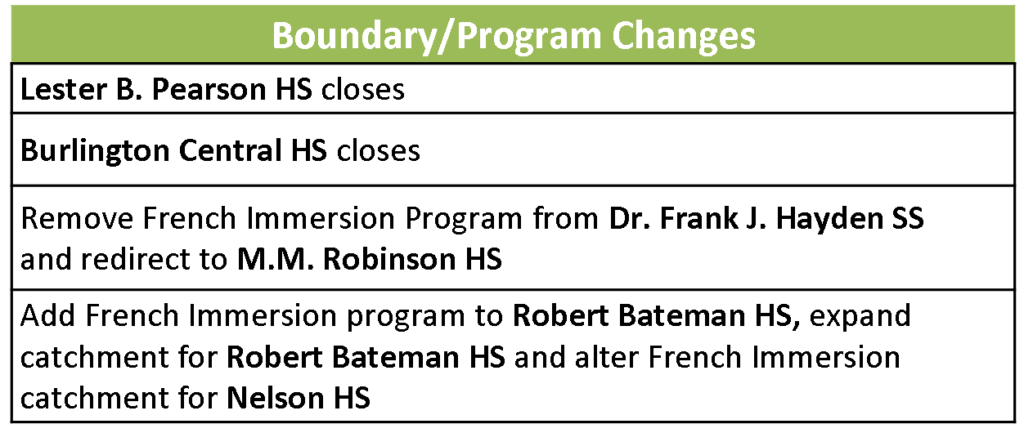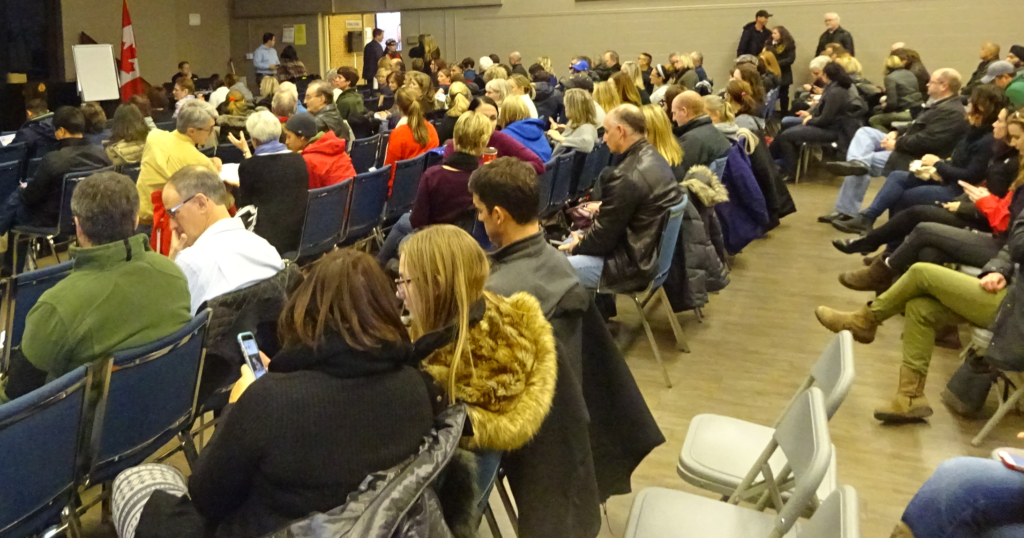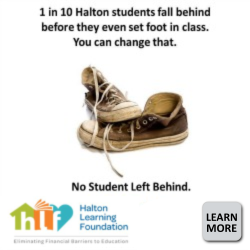 By Pepper Parr
By Pepper Parr
January 4th, 2017
BURLINGTON, ON
Part 1 of a 3 part series.
They met on December 8th at the Gary Allan high school in Burlington for what many thought was going to be a dialogue with questions asked and answered.
It wasn’t that kind of meeting.
Scott Podabarac, an HDSB Superintendent and the Chair of the Program Accommodation Review Committee (PARC) explained that the occasion was going to be used to gather data and Kirk Perris of Ipsos and the man who will serve as the facilitator of the meetings to be held between now and next March began to put a total of 25 questions up on a screen and asking people to give their answer by using a small hand held device.

The time line the Program Accommodation Review committee will be working to.
There were 256 people responding.
The first question put to the audience was – which high school do you children attend. A little awkward for parents with children in two different high schools.
This article is an attempt to analyze the answers that were given and put them in a larger context. It is going to be published in three parts.
What needs to be fully appreciated is the imbalance that impacted everything: 58.6% of the responders were from Central high school; 16.8% from Pearson and 16.8% from Hayden; 2.7% from Aldershot; 2.3% from Nelson; 2% from Bateman and .8% from Robinson.
The issue is the recommendation from the Board to the trustees that two high schools be closed.

The recommendation the Director of Education sent to the school board trustees.
Given that the trustees are completely free to recommend the closing of any high school in the city – they could also decide to direct the Staff to not close any schools but to find a way to change boundaries.
Stewart Miller, Director of Education has said that from his perspective any high school could be closed and that is the decision they must make.
That is a little disingenuous – these trustees are never going to close Nelson, Hayden or Aldershot. Bateman is certainly at some risk – perhaps more so than Central.
Question 2 was: How important is the availability of mandatory/core courses for your child(ren) within your home school.
Very 71.9%; somewhat 22.3%’ not very 4.6%; not at all 1.2%.
Question 3 was: How acceptable is it to attend a school outside of a home school for mandatory/core programming for your child(ren)?
Very 8.4%; somewhat 16%; not very 24.3%; not at all 51.3%
The parents clearly want core courses available from the school in their community. Questions 2 and 3 appear to have been to determine how significant this was to parents and how open they might be to their children getting perhaps a part of their education in a school elsewhere in the city.

There was close to 400 people in the room – 256 of them responded to the 25 questions they were asked. Many of the parents didn’t like the format of the meeting.
The question addressing importance pulled 94.2% – resounding no matter how you read the answer. The question addressing accepting some classes outside the school got an equally resounding (75.6%) not at all interested,
These people want their children educated in their community.
Question 4: How important is the availability of optional elective courses within your home school for your child(ren)?
Very 35.7%; somewhat 44.5%; Not very 14.4%; not at all 5.3
Question 5: How acceptable is it for your children to attend a school outside of a home school for optional/elective courses?
Very 14.2%; somewhat 35.2; not very 26.8; not at all 23.8%
Question 6: How willing are you to have your child(ren) take a mandatory core course in an alternative method, e.g summer school, night school, e-learning or attend another school.
Very 21%; Somewhat 20.6%; not very 21.8%; not at all 36.6%
Question 7: How willing are you to have your child(ren) take an optional elective course in an alternative method, e.g summer school, night school, e-learning or attend another school.
Very 34.7%; somewhat 28.6%; not very 17.8%; not at all 18.9%
Question 8: How important it is for your high school to offer a full range of pathway programming, e.g. Workplace, college, university.
Very 46.7%; somewhat 34.6%; not very 12.8%; not at all 5.8%
Questions 9 through to 16 will be analyzed and commented in a separate article; questions 17 to to 25 in a third article
When one looks at the questions one wonders why they weren’t asked in each community much earlier in the process. What parents want; what they will put up with and what they won’t tolerate would have been very useful to the board as they worked through the process of determining how they were going to resolve the problem of 1800 + classroom seats that don’t have students sitting in them.
To gather that data now and, after analyzing it, place it before the two representatives from each high school seems counterproductive.

There is no mistaking the message. It is getting through to parents?
The Board has placed large signs to the side of every high school telling people that the school is at some risk. They are there now – they could and perhaps should have been put up when the question of a Program Accommodation Review was being considered.
The Gazette takes the view that an informed community can make informed decisions. The Board and the trustees have not delivered on that responsibility.


















Is it possible by boundary changes to keep all schools open and still meet provoncial mandated seat occupancy in each high school? If so will trends keep iut that way in years to come or is this a band aid solution and closing at some point will be needed?
Craig
Much has been discussed about option 19, the one the board has recommended.
If you read the directors preliminary report there are 18 other options showing the results of no closures and varies combinations of schools if they were closed.
It appears school utilization effects several things.
As a quick thought, I don’t think the province has “mandated” seat occupancy for each school, but is more flexible and not absolute.
That is, the province, I believe, sets an occupancy level at which some consideration, such as a PAR, is warranted or can be justified. This could be for one school or a group of schools I think.
That’s what we are seeing here and this was the justification for the PAR I think.
The Trustees have the power to redistribute students, or specific programs that do the same thing, as you suggest. And pursue other community or other entity uses for some space (something being looked into here, and supported by the province), and to keep seats empty or to make a number of changes to keep schools open. The Trustees and Board have this delegated authority.
Practically speaking, this may have limits, as you suggest, but the overall trends in Burlington are not that dire that quick decisions and closures are needed on the present timeline.
In fact, the building of Hayden caused the present excess problem, and this certainly casts serious doubts and questions about the Board’s planning competence. I have written here on this topic previously.
I asked you to consider a few of these questions and issue complications of closing schools, not long ago when you posed similar questions. Did you read it?